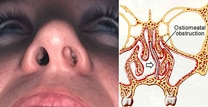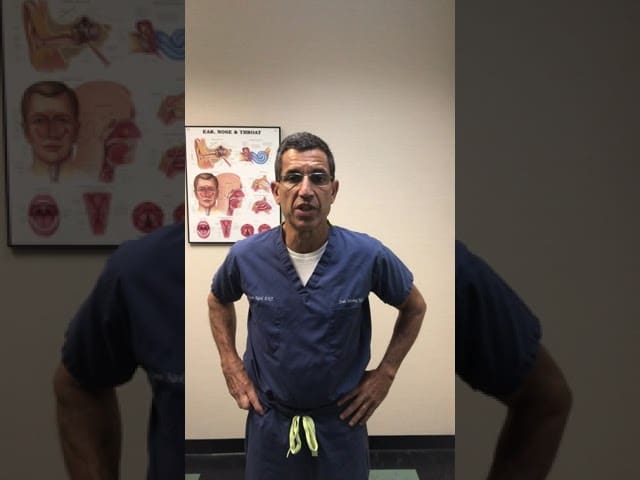Deviated Septum Treatment
Treatment for a deviated septum varies depending on its severity and the symptoms it is causing. For most patients, this condition can be managed through decongestants and antihistamines that aim to reduce nasal congestion. For more severe cases, surgery may be required to correct the displacement. Surgical deviated septum treatment involves a procedure called septoplasty, which repositions the septum in the center of the nose. A septoplasty is often performed in conjunction with rhinoplasty or nose reshaping surgery, which enhances the appearance of the nose while correcting structural abnormalities.
Many people experience a significant lessening of symptoms post-surgery. Results, however, may vary depending on the severity of the deviation. In some cases, the septum may gradually shift over time, and patients may require a second septoplasty to once again relieve symptoms.
Table of Contents
What is a Deviated Septum?
A deviated septum is a common condition that involves a displacement of the septum, the wall that separates the nostrils, to one side of the nose. In adults, the septum is made of cartilage and bone, and helps to support the nose and its mucous membranes, and enables regular airflow.

A deviated septum often develops as a result of an injury to the nose. This condition may cause one nasal passage to be smaller than the other, which can affect breathing if the difference is great enough. A deviated septum may also be the underlying cause of sinus problems, snoring or sleep apnea. Serving Bayside, Queens, Long Island, and surrounding areas.

Causes of a Deviated Septum
In most cases, a deviated septum is present at birth with interchanging symptoms over time. In some cases, a deviated septum is caused by trauma to the nose that displaces the septum. Nasal injuries are often the result of playing sports or car accidents.
Symptoms of a Deviated Septum
As a result of the uneven nasal passages caused by a deviated septum, a patient may have difficulty breathing. Additional symptoms may include:
- Nasal congestion
- Nosebleeds
- Frequent sinus infections
This condition can also lead to facial pain, headaches, and postnasal drip, which can significantly affect the quality of life. A deviated septum may also cause snoring or sleep apnea. Those with only minor displacement may not even be aware of the deviated septum and experience no symptoms at all.
Diagnosis of a Deviated Septum
To diagnose a deviated symptom, a doctor will perform a thorough physical examination, and review all symptoms. In addition, an endoscopy may be performed. An endoscope and a bright light are used to open up the nostrils and nasal passages, enabling a thorough visual evaluation.
What our patients have to say
"I scheduled an appointment with Dr. Werber when I decided to do something about my Sleep Apnea. We setup an in home sleep study , and soon after completed, identified reasons for my issues. After a small procedure to fix my deviated septum and purchasing an oral appliance, I can happily say that I have not slept this well in years. I didn’t realize how much these issues were effecting me until they were fixed. Dr. Werber and his staff were great from start to finish.. I would highly recommend Dr. Werber to anyone who is having sleep issues."
Deviated Septum FAQs
Fixing a deviated septum usually does NOT involve breaking the nose, and there is no swelling, bruising, or change in appearance following the procedure.
What is a Septoplasty?
Septoplasty is a surgical procedure to correct defects or deformities of the septum.
What procedures can be combined with a Septoplasty?
Additionally, a septoplasty may be performed in conjunction with a rhinoplasty in order to ensure that the reshaping of the nose does not result in a reduction of the amount of breathing space.
What is recovery like after a Septoplasty?
Patients who undergo Septoplasty return home the same day and do not experience pain or bruising.
Are my Septoplasty results permanent?
The results of septoplasty are permanent but may take up to a year to become evident because the cartilage and bone of the septum tend to heal slowly.
What is a Rhinoplasty?

Functional Rhinoplasty
Functional rhinoplasty is performed for health purposes to relieve a nasal obstruction. This obstruction is often caused by a deviated septum and may result in breathing problems. Through a simple corrective procedure, these problems can be relieved and a more balanced appearance can also be achieved.
Reconstructive Rhinoplasty
Reconstructive rhinoplasty is performed to repair deformities caused by injury, birth defects or aging. It can also be used to remove external skin tumors or internal nasal tumors. These procedures require extra precision and should only be performed by an experienced surgeon. Aesthetic reshaping is an additional benefit of reconstructive rhinoplasty.

